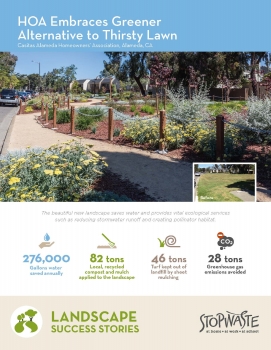Resource Library
- Reports
Basic Financial Statements for the year ending June 2015 for the Alameda County Waste Management Authority, Alameda County Source Reduction and Recycling Board and Energy Council.
- News | 03/14/2016
An article in the March 11, 2016 Oakland Tribune reports on how packaging, labeling, and programmatic differences have led to confusion amongst Bay Area consumers who want to do the "right thing" with their recyclables.
Read More  News | 02/09/2016
News | 02/09/2016An HOA representing more than 400 homes responded to the drought by transforming a large lawn into a water-saving landscape.
Read More- Policies
 Success Stories
Success StoriesThe Reuse Operating Grant Program is available for reuse projects in Alameda County who are in need of funding for staff salaries and supplies related to promotions, educational and outreach programs and/or collection improvements. There is a maximum of $15,000 per request, per year.
Read MoreLawn to Garden Conversion Mini Grants for nonprofit Home Owner Associations (HOAs) provides funding and incentives to convert small lawns (1,000 to 2,500 square feet) into sustainable Bay-Friendly landscapes at HOAs located in Alameda County. As people often regularly congregate at community based facilities, such as HOA common areas, projects in these public settings will provide excellent opportunities to promote lawn conversion programs. The grant goal is to lose a lawn, gain a garden, have community members participate in the conversion, and apply what they have learned to their own lawns. Technical assistance, free materials and grant funding provides support to HOAs to convert a common area lawn to a sustainable garden.
- Read More
Table compares bag purchasing data from 2012 to 2013 from 5 different types of large and small chain stores. Data for a total of 69 stores across 5 chain stores (all located in Alameda County) was analyzed to assess changes in bag purchasing activities as a result of Ordinance 2012-2.
- Read More
Staff observed shoppers leaving retail stores for one hour (pre and post ordinance) and counted the number and type of bag (or lack of a bag) that customers used to carry their purchases. Observations were made at 17 stores that included a variety of store types such as grocery, pharmacy, convenience and big box stores.